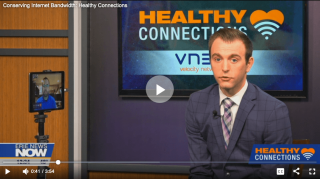The New Normal – Hybrid Work Model

This guy is mocking how cluttered my home office looks right now.
Just over a decade ago, our company experienced a growth spurt that sent a half dozen employees, including this writer, home for nine months. As a top tier Managed Service Provider (MSP), Velocity Network was able to deploy VPNs, firewalls, phones, and network access to the six of us in less than a day. It was a great experience, but eventually, we acquired more office space and things returned to normal, including the commute.
Never would I have imagined that in 2020, 90% of our staff would be sent home to work remotely for weeks with no clear endpoint in sight. After all, we just moved into a state-of-the-art building that was custom designed for how we work and interact. Like almost every business in the area, we’ve had to pivot to a hybrid work model.
Now that Pennsylvania Governor Tom Wolf has lifted restrictions on some businesses across the state, many companies will be looking to larger corporations as an example of how to get people safely back to work.
Over the last few months, many businesses have discovered that they are able to operate just fine with their employees working from home offices. Nationwide Insurance has recently declared that they will be closing all but four of their main corporate campuses and having work-from-home setups for most of the other locations.
With the help of VPNs, webcams, and stable internet, employees can perform their jobs as well as and often beyond what they were able to do before the pandemic.
Morgan Stanley CEO James Gorman is quoted as saying that since the pandemic, it’s become clear that the bank needs “much less real estate” going forward. They have had approximately 90% of their employees working from home successfully.
While this works well for some job sectors, it’s infeasible for many others where employees need to be on premise.
In the near term, getting folks back to work while minimizing the spread of the disease may require some hybrid model as well.
Some have been applying what we know about scientific facts on COVID-19 and good old-fashioned mathematics. As an example, it appears that from the time a person is infected, it takes approximately three days before they are communicable. The theory is that people would be able to spend time around each other for a short time, followed by a stretch of lockdown time. In this model, it would be a 4-day shift followed by ten days off. The time off would allow for symptoms to emerge if the infection spread at the workplace.
This and variations of the model might be what is needed to help get some people back to work.
The dependency on human resources experts will also be in high demand as businesses and organizations navigate the waters of liability, employee health concerns, and frequent communications.
It’s impossible to see what is the best approach will be for every business as each one is unique, but it does seem that a hybrid model of in work-office, home-office, and creative work schedules will be commonplace.
Hybrid Work Models – Things to Consider
IT / Security / Cloud Applications
- Organizations will now need to manage more devices as employees might have both a work from home and a work from the office configuration.
- Employees might have brought their workstation home during the initial phases of the COVID-19 pandemic so companies might need to invest in additional devices (or more mobile devices) to enable a more flexible work environment.
- Applications that have traditionally been fixed to the office or headquarters, might also need to be migrated to the Cloud (Microsoft 365 / Microsoft Azure) to allow the ability to be always on or connected.
- Employees that are relying more on video or cloud applications will also need to evaluate their broadband connectivity at home to increase it to accommodate the additional demands on their network.
- Security practices that were curtailed to allow employees to quickly migrate to a remote scenario will need to be improved with more advanced systems like SonicWall to ensure access is secure.
- Organizations will need to review their current telecom systems and look to move to a Hybrid IP system, such as Switchvox, to allow for Softphones or Mobile Applications to ensure that employees are connected to each other as well as clients.
- Development of Video Collaboration rooms that enable employees to connect with each other and clients from both the office and at home.
Human Resources
- As more employees are working from home, they will need to have more on demand and remote access to their HR Systems.
- Cloud based applications like Paycor, Paycom, and others are going to be in higher demand to enable employees and employers to remotely manage HR practices.
- HR will also need to develop or review their work from home policies and practices to allow for the hybrid work model that traditionally might not have impacted as many employees.
Client Interactions
- With on-site and in person client visits halted or extremely reduced, organizations need to increase their use of Video Collaboration tools like Microsoft Teams or other applications.
- Sales that traditionally were conducted in person will now have to be transitioned to over the phone or video. This transition might require additional training to improve the customer experience over the phone.
- Phone systems need to be modified to provide clients with the easiest path to connect with employees for sales or support needs.
Online Resources
View all the segments on Erie News Now.
Tune in to Erie News Now on Wednesdays at 12:30 PM and 5:30 PM.
